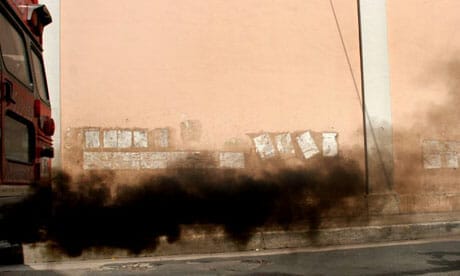The total number of workers killed or injured in the collapse of a building in Savar, Bangladesh on April 24, 2013 is not yet known, as rescuers continue to search for survivors. As of Sunday, April 28th, the count was at least 377 dead. Many of those killed were workers at clothing factories housed in the building, known as Rana Plaza, where fire broke out in the wreckage of the building, temporarily suspending rescue efforts as of April 24. Efforts will restart with the aide of heavy equipment, which had previously been avoided in an effort to not injure those still buried in the rubble. There no longer are assumed to be any victims remaining alive, although hundreds remain unaccounted for. The death toll surpassed a fire five months ago that killed 112 people and brought widespread pledges to improve worker-safety standards. But since then, very little has changed in Bangladesh.
Human Rights Watch reported on the building collapse, noting that it knows of no cases in which the Bangladeshi government has ever prosecuted a factory owner over the deaths of workers.
USA Today reported on the tragedy with the news that Mohammed Sohel Rana, the fugitive owner of the illegally-constructed building, was apprehended by a commando force while trying to flee to India. Rana was returned to Dhaka to face charges of negligence. Rana had been on the run since the building collapsed Wednesday. He last appeared in public Tuesday in front of the Rana Plaza after huge cracks appeared in the building. Witnesses said he assured tenants, including five garment factories, that the building was safe. Hours later, the Rana Plaza was reduced to rubble, crushing most victims under massive blocks of concrete.
Human Rights Watch reported on the building collapse, noting that it knows of no cases in which the Bangladeshi government has ever prosecuted a factory owner over the deaths of workers. Many factory owners in Bangladesh are parliamentarians or members of the main political parties. In an interview with a government minister in 2011, the minister told Human Rights Watch that it would be “impossible” to improve workers rights so long as factory owners were senior members of political parties.
According to the Human Rights Watch report, Bangladesh has notoriously poor workplace safety inspection mechanisms. The Ministry of Labour’s Inspection Department, responsible for monitoring employers’ adherence to Bangladesh’s Labour Act, is chronically under-resourced. In June 2012, the Inspection Department had just 18 inspectors and assistant inspectors to monitor an estimated 100,000 factories in Dhaka district, where the Rana building is located. The garment sector alone employs an estimated 3 million workers.
According to the US Department of Labor Bureau of International Labor Affairs, workers in the Bangladeshi garment factories are primarily women – 75 to 90 percent – and children ranging in age from eight to fourteen years. Most of the children are girls with an average age of just over 13 years. Working conditions are described in the USDOLreport as follows:
Garment factories are located in multi-storied buildings throughout Dhaka including Mirpur, Malibagh and Rampura districts (allegedly one of the worst areas), and the Free School District area. Working conditions in general in Bangladesh are far below western standards. On a par with other factory settings, garment factories are often dimly lit, with poor ventilation, and open for very long hours. However, some factories operate with good lighting and are not overly hot or crowded. The workers, mostly female, work without a break during their shift. Too often the factory doors are locked. Sometimes guards with keys stand by the locked gate; other times no one able to unlock the iron grating is near. Many times the locked gate is the only entrance or exit to a factory. The workers, including children, are frequently locked into their work place at the beginning of the morning shift and not let out until the end of the workday, and in some cases not until the next day. Overtime hours occur during peak periods in the production cycle when manufacturers are rushing to fulfill their export quotas. AAFLI’s 1994 survey of garment factories found that, like adult workers, children typically work 10 to 14 hours a day, with a half-day off on Friday.
The similarities are chilling to the working conditions of American garment workers at the Triangle Shirtwaist Factory prior to the tragic fire on March 26, 1911 that forever bears the same name. The horrific deaths from the Triangle fire, witnessed through photographs printed in the news media around the world, spurred a swift and aggressive response by workers and labor activists. Their response led to the establishment of many of the protective organizations American workers now rely on, including the workers’ compensation system, the American Society of Safety Engineers, and the U.S. Department of Labor.
As with the Triangle fire, this should be a call to action as well as a time for reflection. We, as consumers, are tied to the businesses in Bangladesh that supply garments to American companies. That connection gives us the power to effect change in the working conditions of the Bangladeshi factories by insisting that American corporations purchase garments for sale in the US from safety-inspected factories that meet minimal international standards for basic worker protection.
Photo credit: dblackadder / Foter.com / CC BY-SA



















